Natural perfumes from pressed flower petals start with careful extraction of essential oils using methods like steam distillation, solvent extraction, or simple oil infusion. You'll need fresh flowers, carrier oils, and basic tools like glass containers and a mortar and pestle to release the petals' aromatic compounds. The process requires patience as you combine your floral extracts with an alcohol base and allow them to mature. Discovering the art of natural perfumery opens up a world of signature scents and time-honored techniques.
The Art and Science Behind Floral Perfume Extraction
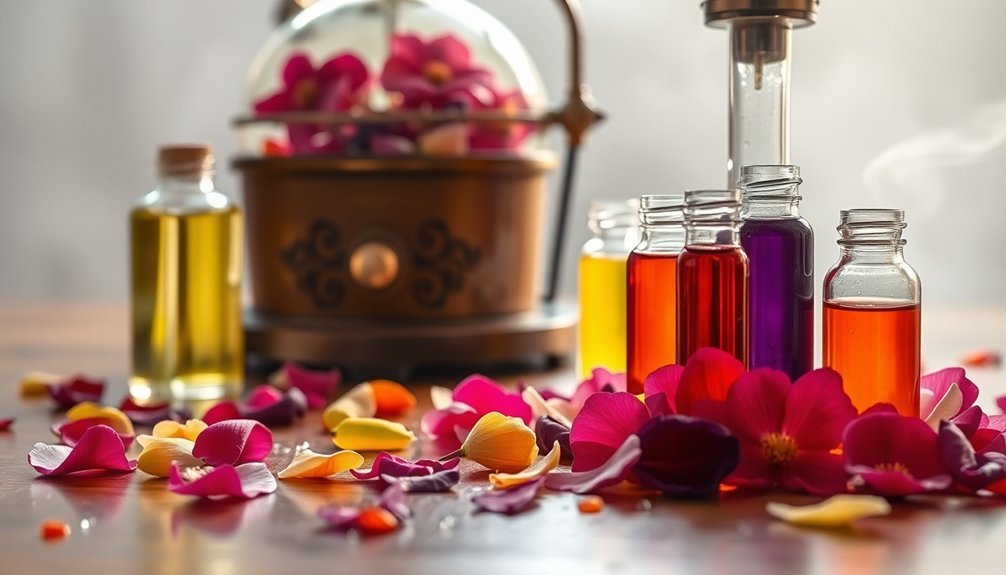
While creating natural perfumes from flowers may seem straightforward, the extraction process requires both artistic finesse and scientific precision.
You'll find several methods, each with unique advantages for capturing nature's delicate fragrances.
Steam distillation offers a pure, solvent-free approach that's perfect for lavender and chamomile, while also producing useful hydrosol.
If you're working with delicate flowers like jasmine or rose, you might opt for solvent extraction, though it requires careful purification.
The traditional enfleurage method, while labor-intensive, captures the most subtle scents without heat damage.
For modern perfumers seeking precision, supercritical CO2 extraction provides exceptional purity but demands specialized equipment. Simple maceration in oils can provide an accessible alternative for small-scale production without complex machinery.
Each technique represents a careful balance between preserving the flower's natural essence and achieving an efficient extraction process.
Essential Tools and Materials for Pressed Flower Perfumes
Creating pressed flower perfumes requires a specific set of tools and materials to achieve professional results.
You'll need high-quality glass containers and borosilicate beakers to protect your fragrances from chemical reactions and light exposure. For the extraction process, you'll want a reliable mortar and pestle to release essential oils from your flower petals. Similar to creating wax sachets, you should add approximately 50 drops of fragrance to achieve the ideal scent intensity.
- Fresh, fragrant flowers like roses, jasmine, or lavender serve as your base ingredients.
- Carrier oils such as jojoba or almond oil help extract and preserve the floral scents.
- Natural fixatives including orris root powder or glycerin stabilize your perfume.
- Essential tools like cheesecloth, funnels, and thermometers guarantee proper processing.
Don't forget to use stainless steel measuring tools for accuracy and a separatory funnel to isolate the essential oils from hydrosol during the final stages.
Step-by-Step Guide to Creating Natural Floral Fragrances
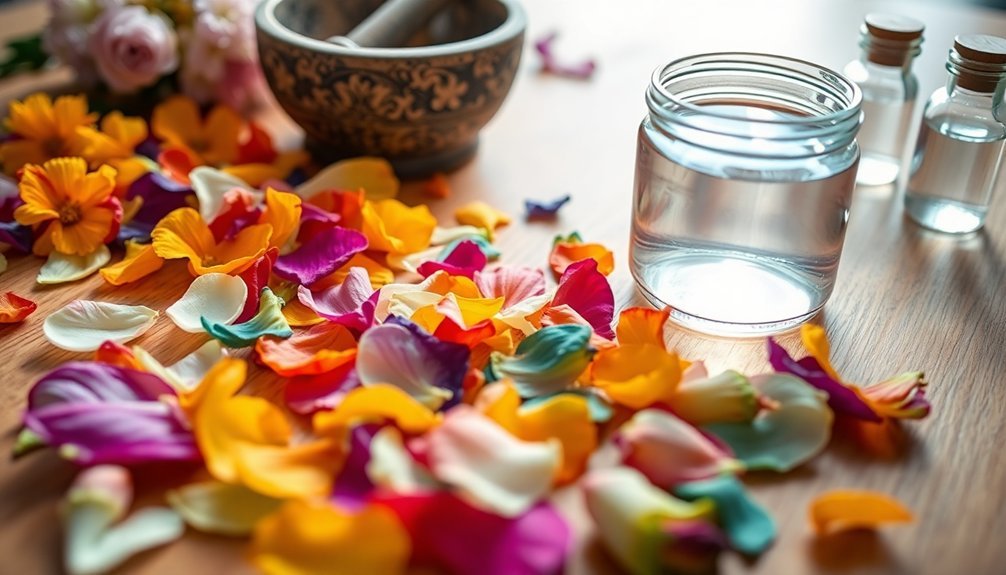
Four essential steps transform fragrant flower petals into elegant natural perfumes.
First, you'll need to infuse fresh petals in a carrier oil like jojoba or sweet almond oil, letting them steep in a sealed jar for 24-48 hours in a cool, dark place. You can use either maceration or distillation methods, depending on how intense you want the scent. Different combinations of flowers like roses and jasmine can create unique signature blends.
Next, create your alcohol base by mixing vodka or witch hazel with distilled water in a 3:1 ratio. Combine this with your infused oil and shake well.
Let the mixture mature for several weeks, then strain it to remove any sediment.
Test your perfume on your skin and adjust the fragrance by adding more flower oil, water, or complementary scents.
Finally, bottle your creation in dark glass containers and store it properly to preserve its natural essence.
Selecting the Perfect Flowers for Your Signature Scent
Now that you've mastered the basic steps of perfume-making, choosing the right flowers will shape your signature scent. When selecting your flowers, consider their unique aromatic profiles and the emotions they evoke.
Night-blooming flowers like tuberose and jasmine offer particularly intense fragrances, while exotic blooms like ylang ylang and frangipani bring tropical complexity to your blend.
- Start with classic favorites like jasmine or rose – these "royal" flowers provide a luxurious foundation.
- Add depth with heady florals like tuberose, known for its metallic and buttery undertones.
- Include seasonal blooms like honeysuckle or orange blossoms for vibrant, fruity notes.
- Experiment with night-blooming flowers, which typically yield stronger fragrances due to their natural pollination patterns.
Remember that fresh flowers require significant quantities for extraction, so plan your harvesting accordingly.
Oil-Based vs. Water-Based Extraction Methods
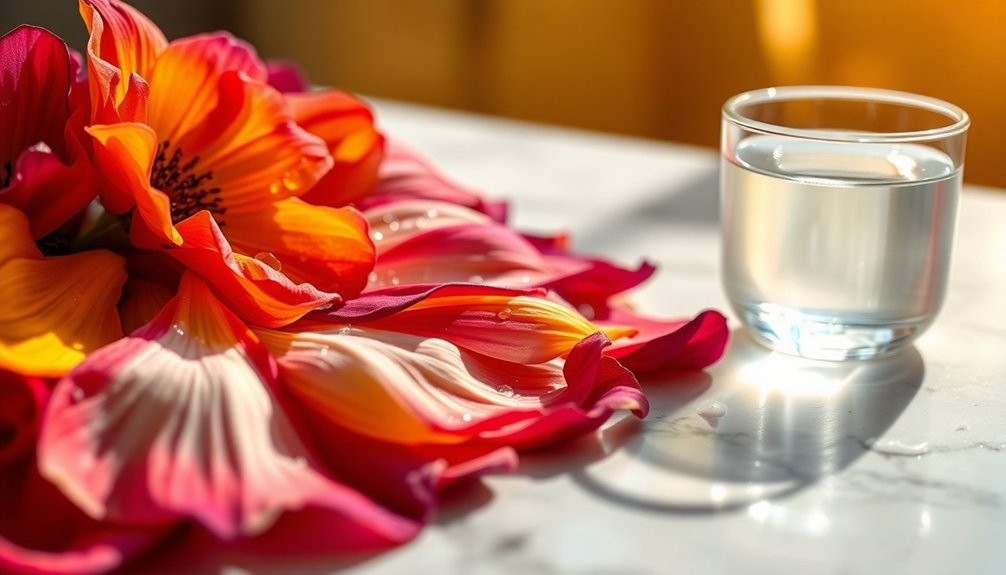
When you're choosing between oil-based and water-based extraction methods for your floral perfumes, you'll find that oil-based methods like steam distillation and solvent extraction typically produce longer-lasting, more concentrated scents compared to water-based alternatives.
Oil-based extractions work best with robust flowers like lavender and rose, while water-based methods suit delicate blooms such as jasmine and gardenia, creating lighter, more subtle fragrances.
Your choice of method will greatly impact both the intensity and longevity of your perfume, with oil-based extractions generally providing more potent results that can last several hours longer than their water-based counterparts.
Base Solvent Comparison
The choice between oil-based and water-based extraction methods greatly impacts the final quality and character of natural perfumes.
While oil-based methods like enfleurage and maceration tend to capture fuller, richer scent profiles, water-based techniques like steam distillation yield lighter, more delicate fragrances.
You'll notice these key differences between the solvents:
- Oil-based extractions preserve delicate compounds better, as they don't require heat, while steam distillation can alter some fragrance components.
- Water-based methods produce both essential oils and hydrosols, offering two distinct product types.
- Oil carriers like jojoba provide longer-lasting scents and better skin absorption than water-based products.
- Supercritical CO2 extraction bridges both worlds, offering precise compound selection without traditional solvents, though it's more technically complex.
Scent Duration Differences
Understanding scent duration differences between extraction methods can greatly impact your perfume-making success. Oil-based methods consistently deliver longer-lasting fragrances compared to water-based alternatives.
Steam distillation, solvent extraction, enfleurage, and supercritical fluid extraction all yield concentrated oils with robust, enduring scents due to their ability to preserve aromatic compounds.
If you're using water-based methods like hydrosols or maceration, you'll notice markedly shorter scent duration. While hydrosols offer gentle, subtle fragrances ideal for skincare, they won't give you the same lasting power as oil-based extracts.
You'll need to take into account using preservatives with water-based products to maintain their stability. For the most long-lasting natural perfumes, you'll want to focus on oil-based extraction methods or combine them with water-based ones to enhance longevity.
Best Flowers Per Method
Selecting the right flowers for each extraction method plays an essential role in achieving excellent fragrance results.
You'll find that oil-based extractions work best with robust flowers like roses and lavender, while water-based methods excel with heat-tolerant blooms like geraniums and tagetes.
For superior results, match these flowers to their ideal extraction methods:
- For maceration, choose fresh roses, lavender, or geranium petals that contain minimal moisture.
- When using enfleurage, opt for delicate jasmine, tuberose, or gardenia flowers.
- Steam distillation works beautifully with lavender, tagetes, and heat-resistant geraniums.
- Hydrodistillation is perfect for roses and geraniums that can withstand direct water contact.
Remember that some flowers, like jasmine and tuberose, are too delicate for water-based methods and require gentle oil-based extraction to preserve their precious fragrances.
Storage and Preservation of Natural Flower Perfumes

Preserving natural flower perfumes requires careful attention to storage conditions that protect their delicate fragrances.
You'll want to store your natural perfumes in a cool, dark place where the temperature stays around 60 degrees. Don't keep them in your bathroom, as humidity and temperature changes can damage the fragrance.
Keep your perfumes in their original bottles and boxes, which are designed to protect them from air and light. It's crucial to maintain an airtight seal to prevent oxidation.
If you're storing special blends, consider double-packing them in air-tight bags for extra protection. Always store bottles upright and avoid shaking them, as this creates bubbles that speed up oxidation.
Check your perfumes regularly for any signs of discoloration, which can indicate they're starting to degrade.
Blending Different Flower Varieties for Unique Aromas
With your natural perfumes properly stored, you can begin exploring the art of blending different flower varieties.
Combine strongly scented flowers like roses and jasmine with subtle varieties such as sweet pea and sweet alyssum to create balanced fragrances.
You'll want to layer your scents carefully, following nature's hierarchy of fragrance notes:
- Begin with quick-evaporating top notes like citrus oils
- Add middle notes such as cardamom or black pepper
- Ground your blend with lasting base notes like frankincense or jasmine
- Incorporate multi-note oils like lavender or ylang-ylang to bridge the layers
Remember to harvest your flowers early in the morning when their fragrance is strongest, and consider adding herbs like rosemary or mint for added complexity.
Allow your blend to infuse for several days to achieve the fullest expression of scents.
Benefits of Using Pressed Flower Petals in Perfumery
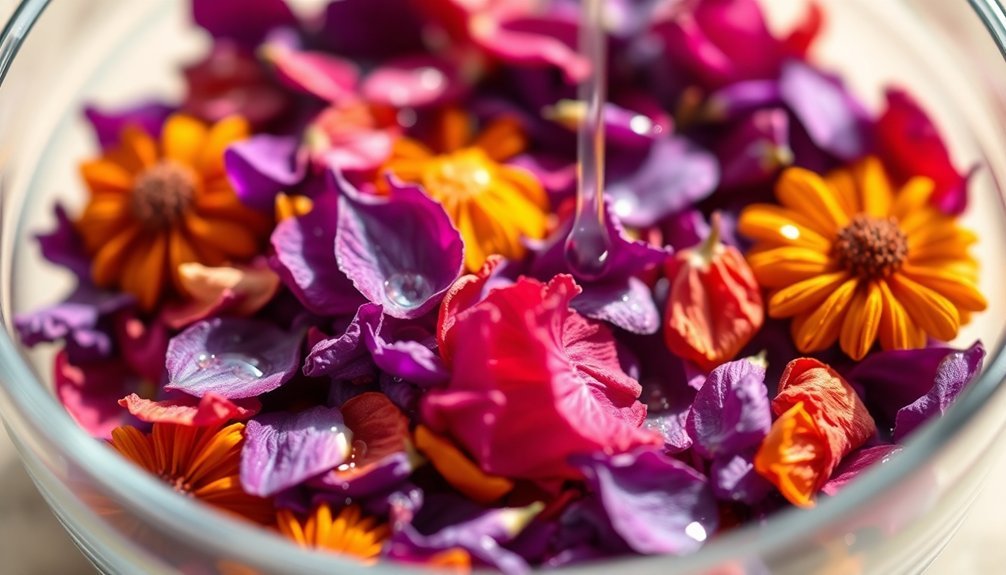
When crafting natural perfumes, pressed flower petals offer remarkable benefits that extend far beyond their enchanting fragrances.
You'll find that rose petals, in particular, provide a classic, sweet aroma while delivering powerful skincare benefits through their rich vitamin C and antioxidant content. By using natural petals instead of synthetic fragrances, you're avoiding artificial chemicals while embracing ingredients that can repair and tighten your skin.
The extraction process is surprisingly simple – you can use distilled water or vodka to draw out the aromatic compounds.
What's more, these natural ingredients support your immune system while creating a calming atmosphere.
Whether you're making perfumes for personal use or commercial purposes, you'll appreciate that pressed flower petals offer a time-tested, wholesome approach that connects you to ancient wellness traditions.
Common Challenges and Solutions in Natural Perfume Making
While pressed flower petals offer beautiful fragrance possibilities, creating natural perfumes comes with distinct challenges that require thoughtful solutions.
You'll need to navigate various obstacles while maintaining product quality and sustainability.
- Raw material variability affects your perfume's consistency – factors like climate, soil conditions, and harvest timing can alter the aromatic compounds in your flower petals.
- Extraction methods must be carefully chosen – traditional steam distillation might damage delicate floral notes, making gentler techniques like enfleurage necessary.
- Shelf life tends to be shorter compared to synthetic fragrances – you'll need proper preservation methods to maintain the perfume's integrity.
- Sustainable sourcing requires extra diligence – you must guarantee your flower suppliers follow ethical harvesting practices to protect plant species and support biodiversity.
Frequently Asked Questions
Can People With Pollen Allergies Safely Use Flower Petal Perfumes?
If you're allergic to pollen, you should be cautious with flower petal perfumes. While processing removes most pollen, you'll want to patch test first and consult your doctor before regular use.
How Do Seasonal Changes Affect the Scent Intensity of Flower Perfumes?
You'll notice floral perfumes change intensity with seasons. They're stronger in summer heat, subtle in spring, moderate in fall, and need higher concentrations in winter when cold temperatures dampen fragrance molecules.
Are There Specific Flowers That Should Never Be Used in Perfumes?
You should avoid highly toxic flowers like lily of the valley, oleander, and foxglove in perfumes. They're dangerous to handle and extract. Instead, rely on their synthetic fragrance recreations for safe perfume making.
What Temperature Changes Can Affect the Quality of Natural Perfumes?
You'll notice that high temperatures make your perfume evaporate faster, while cold temperatures slow it down. Humidity affects how long scents last, and your skin's temperature directly impacts the fragrance's projection.
Can Dried Flower Petals Produce the Same Fragrance as Fresh Ones?
No, you won't get identical fragrances from dried and fresh petals. While dried petals can produce perfumes, they've lost some volatile compounds during drying, resulting in a simpler scent compared to fresh petals' complex notes.
In Summary
Creating natural perfumes from pressed flower petals isn't just a craft – it's an art form you'll love mastering. Whether you've chosen oil-based methods or water extraction, you're now equipped to blend unique fragrances using nature's finest blooms. Keep experimenting with different flower combinations and extraction techniques, and you'll develop your signature scent while maintaining the pure essence of botanical perfumery.

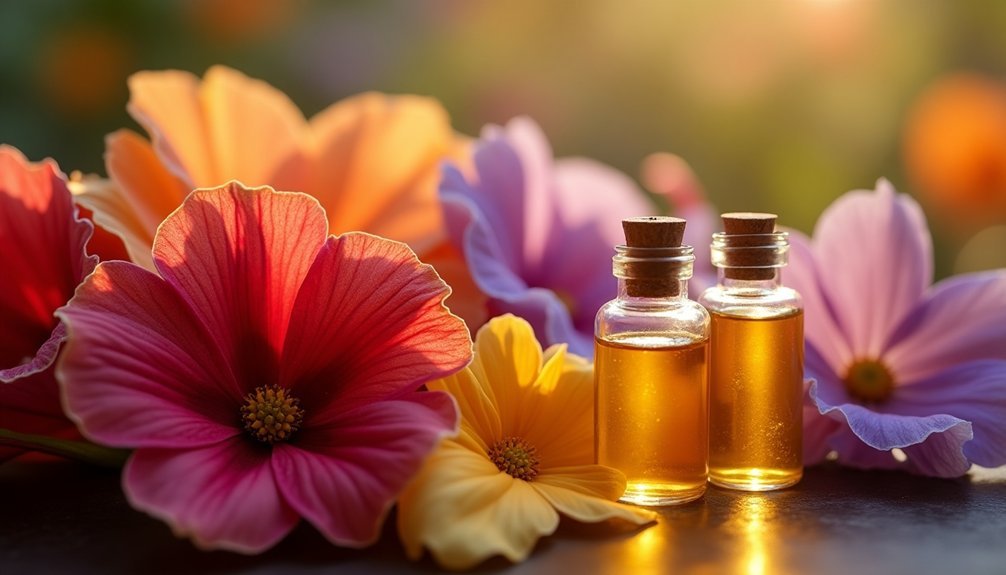



Leave a Reply